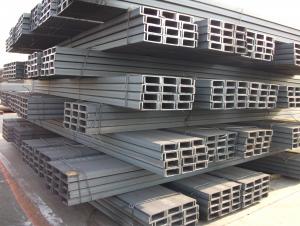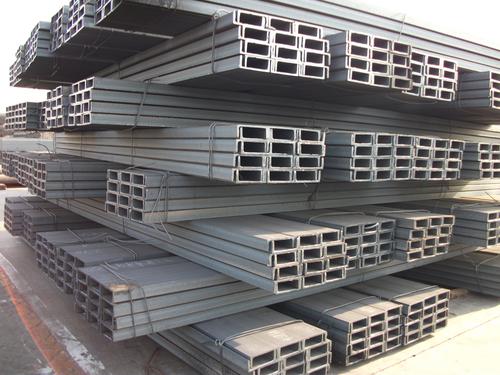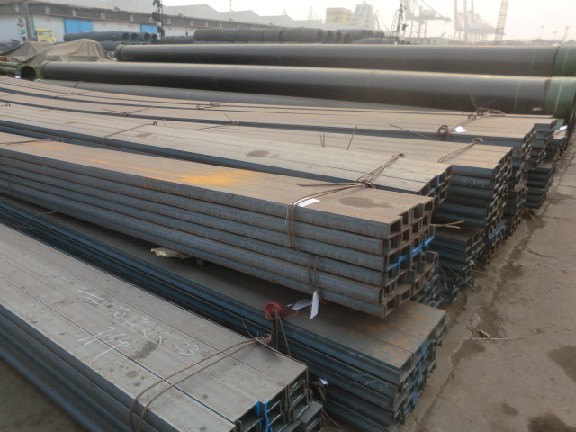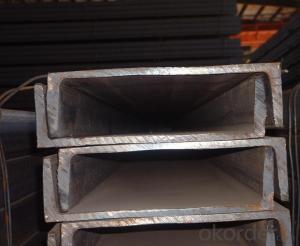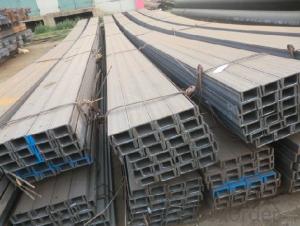upn
- Loading Port:
- China Main Port
- Payment Terms:
- TT OR LC
- Min Order Qty:
- -
- Supply Capability:
- -
OKorder Service Pledge
OKorder Financial Service
You Might Also Like
Product Description:
Specifications of UPN Channel Steel:
1.Our UPN Channel Steel has lots of advantages, just as followings:
a) At reasonable price and good quality.
b) To be convenient in construction and to save much time and labor.
c) The length of UPN can be manufactured according to customer’s requirements.
d) The UPN Channel Steel has strong mechanical strength.
e). The UPN Channel Steel possesses various kind of fittings, through which it is suitbal for many combinations.
f) Our UPN Channel Steel is attractive in appearance as well as beautiful in design
g) Free from slotted punching
2. The detailed sections of our UPN Channel Steel can be found in table-1
UPN U CHANNEL | Standard h | Sectional b | Dimension s | t | Mass: Kg/m |
| (mm) | (mm) | (mm) | (mm) |
|
80x45 | 80 | 45 | 6.0 | 8.0 | 8.64 |
100X50 | 100 | 50 | 6.0 | 8.5 | 10.6 |
120x55 | 120 | 55 | 7.0 | 9.0 | 13.4 |
140x60 | 140 | 50 | 7.0 | 10.0 | 16.0 |
160x65 | 160 | 65 | 7.5 | 10.0 | 18.8 |
180x70 | 180 | 70 | 8.0 | 11.0 | 22.0 |
Table-1
Note: we are definitely good at manufacturing and supplying UPN channel steel as per S235JR. Also, we are willing and able to provide our customers UPN channel steel in other sizes, which depends on customers’ concret requirements for the quantity.
3. The chemical composition of UPN Channel Steel as per S235JR is shown in the table-2
Alloy No | Element(%) | ||||
C | Mn | S | P | Si | |
S235JR | 0.12—0.20 | 0.3—0.7 | ≤0.030 | ≤0.030 | ≤0.20 |
Table-2
4. The mechanical property of UPN Channel Steel as per S235JR is shown in the table-3-1 and table-3-2
Alloy No | Yielding strength point( Mpa) | |||
Thickness (mm) | ||||
≤16 | >16--40 | >40--60 | >60--100 | |
≥ | ||||
S235JR | 235 | 225 | 215 | 195 |
Table-3-1
Alloy No | Tensile strength (Mpa) | Elongation after fracture(%) | |||
Thickness (mm) | |||||
| ≤16 | >16--40 | >40--60 | >60--100 | |
≥ | |||||
S235JR | 340--510 | 24 | 23 | 22 | 27 |
Table-3-2
Applications of UPN Channel Steel:
The UPN Channel Steel can be applied to construction of warehouses, workshops, sport stadiums and car parks etc.The hot rolled channel steel belongs to carbon structural steel which is applied to in the field of construction and machinery.In details, the hot rolled channel steel is usually used for arch-itechtural structure, and they could be welded in order to support or hang a vari-ety of facilities. They are also usually used in combination with I beam. Generally,the hot rolled channel steel we supply must possess perfect welding property, riveting property and mechanical property and so on.
- Q: How do steel channels contribute to structural stability?
- The contribution of steel channels to structural stability is multifaceted. Primarily, they provide additional strength and support to the structure. The unique shape of steel channels, characterized by a wide base and narrow top, enables them to bear heavy loads and withstand bending or twisting forces. Consequently, they are highly suitable for incorporation into beams, columns, and other structural elements. Furthermore, steel channels can serve as reinforcement within concrete structures. When integrated into concrete, they enhance the overall strength and durability of the structure. The utilization of steel channels aids in distributing the load across a larger surface area, thereby diminishing stress concentrations and averting localized failures. Additionally, steel channels have the capacity to interconnect, forming a framework that heightens the rigidity of the structure. By establishing an interconnected network of steel channels, a system capable of resisting lateral forces such as wind or earthquakes is created. This fortifies the stability of the structure and safeguards it against collapse or damage during extreme events. Moreover, steel channels possess exceptional resistance to corrosion, a pivotal characteristic for ensuring long-term structural stability. Unlike other materials, steel channels do not easily deteriorate when exposed to moisture, chemicals, or extreme temperatures. This durability ensures the integrity of the building remains intact throughout its lifespan. In conclusion, steel channels play an indispensable role in augmenting the structural stability of buildings and other structures. Their strength, versatility, ability to reinforce concrete, and resistance to corrosion render them an essential component in the realm of construction.
- Q: How do steel channels perform in terms of acoustic insulation?
- The acoustic insulation properties of steel channels are generally not well-known. This is because steel, being a dense material, tends to conduct sound rather than absorb or block it. Consequently, steel channels may not provide significant acoustic insulation by themselves. However, their effectiveness can be enhanced by incorporating additional materials or techniques that improve soundproofing. For example, introducing insulation material, such as mineral wool or acoustic foam, between the steel channels can help to dampen sound transmission. Furthermore, the use of resilient mounting systems or decoupling techniques can further decrease the transfer of vibrations and noise through the steel channels. Therefore, although steel channels alone may not offer substantial acoustic insulation, they can play a role in a broader soundproofing strategy when combined with appropriate materials and techniques.
- Q: Is the channel 20 the same as the channel 20b?
- No, channel 20, a and B two.20A specifications are: 200*73*7.0, weight per meter is 22.637kg20b specifications are: 200*75*9.0, weight per meter is 25.777kg
- Q: Small Huxing, suitable for what modeling ceiling, channel across 4.8 meters, 60cm file, middle angle steel, 60cm first gear, what kind of modeling ceiling?
- Channel steel in the laying of must have specifications, that is, there are spacing, such as the lattice of 60cm*60cm; in this case, the most direct is to do lattice ceiling, it is up to the concave shape of the lattice;
- Q: Can steel channels be used for supporting mezzanine floors?
- Yes, steel channels can be used for supporting mezzanine floors. Steel channels provide excellent structural support and stability, making them a suitable choice for supporting the weight of mezzanine floors.
- Q: What are the different finishing techniques for steel channels?
- Some different finishing techniques for steel channels include hot-dip galvanizing, powder coating, painting, and electroplating.
- Q: What are the different methods for transporting and handling steel channels?
- There are several methods for transporting and handling steel channels, including the use of forklifts, cranes, overhead lifting devices, and manual labor. Forklifts are commonly used for moving and transporting steel channels within a facility or loading them onto trucks for transportation. Cranes are used for lifting and moving heavier or larger steel channels, especially in construction sites. Overhead lifting devices, such as hoists or slings, can also be used to handle steel channels. Additionally, manual labor can be employed for smaller or lighter steel channels, where workers can manually carry or push them into place. The specific method chosen depends on the size, weight, and location of the steel channels, as well as the available equipment and resources.
- Q: Can steel channels be customized according to specific requirements?
- Yes, steel channels can be customized according to specific requirements. Steel channels are commonly used in construction and manufacturing industries for various purposes such as framing, support, and reinforcement. They can be customized in terms of size, shape, length, thickness, and material composition to meet specific project requirements. Customization of steel channels allows for greater flexibility and adaptability in various applications. For instance, the size and shape of the channel can be altered to fit specific structural designs or to accommodate specific loads and stresses. The length of the channel can be customized to suit the dimensions of the project, while the thickness can be modified to provide the desired strength and durability. Furthermore, steel channels can be customized in terms of material composition. Different types of steel, such as carbon steel, stainless steel, or alloy steel, can be utilized based on the specific requirements of the project. This customization ensures that the steel channel possesses the necessary properties, such as corrosion resistance, heat resistance, or high tensile strength, to withstand the intended application. Overall, steel channels can indeed be customized according to specific requirements, offering a versatile solution for various construction and manufacturing needs.
- Q: What are the factors to consider when selecting steel channels for a project?
- When selecting steel channels for a project, there are several important factors to consider. First, it is crucial to determine the specific load requirements of the project. This includes considering the weight that the steel channels will need to support and the stress or pressure they will be subjected to. Next, the dimensions and sizes of the steel channels should be evaluated. This involves assessing the height, width, and thickness of the channels to ensure they are suitable for the intended application and can provide the necessary structural support. The material grade of the steel channels is another vital factor. Different steel grades offer varying levels of strength, durability, and corrosion resistance. It is important to select a grade that aligns with the environmental conditions and longevity requirements of the project. Furthermore, the fabrication and installation process should be considered. Factors such as ease of welding, cutting, and forming the steel channels can impact the overall efficiency and cost-effectiveness of the project. Lastly, factors like cost, availability, and supplier reputation should also be taken into account. It is essential to source the steel channels from reliable and reputable suppliers who can provide high-quality products within the project's budget.
- Q: Can steel channels be used for creating decorative elements?
- Yes, steel channels can definitely be used for creating decorative elements. Steel channels are versatile and can be shaped, cut, and welded into various forms and designs. They can be used to create decorative elements such as ornamental railings, gates, fences, sculptures, and other architectural details. Steel channels provide a modern and sleek look while also being durable and long-lasting. They can be finished with different coatings or paint to enhance their aesthetic appeal. Whether it's for indoor or outdoor applications, steel channels offer a wide range of possibilities for creating beautiful and unique decorative elements.
Send your message to us
upn
- Loading Port:
- China Main Port
- Payment Terms:
- TT OR LC
- Min Order Qty:
- -
- Supply Capability:
- -
OKorder Service Pledge
OKorder Financial Service
Similar products
Hot products
Hot Searches
Related keywords
